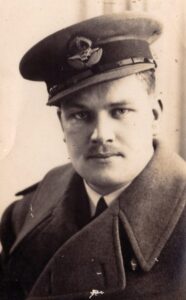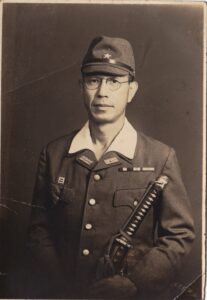 Dr. Aidan MacCarthy
Dr. Aidan MacCarthyThere are times when you read history you come across a story that literally defies belief. Yet, fate can bring together events beyond the imaginations of any writer and the most unlikely of people show us the strength and nobility of the human character. Such is the story of Dr. Aidan MacCarthy.
MacCarthy was born in Castletownbere, Beara Peninsula County Cork, Ireland in 1914. His family’s story was already remarkable; having saved to buy a small store and with a keen eye for opportunity and investment they were prominent members of the community and Ireland’s new Catholic middle class. Yet, despite their prosperity, the family’s remote location and lack of access to traditional medical care meant that his mother often improvised medicines and treatments for her family. The interest in medicine and inventiveness of his parents would be passed on to Aidan and serve him well.
MacCarthy studied medicine University College Cork (UCC) and graduated a doctor in 1938. However, medicine was a jealously guarded profession, and MacCarthy found that his lack of family connections prevented him from establishing a practice (He was not alone; it was estimated that 50 to 60 percent of Ireland’s newly graduated doctors had to leave the country in search of employment and experience). MacCarthy traveled to England in search of opportunity but again found the doors of the medical profession closed to him. On September 3, 1939, Britain, in response to the German invasion of Poland, declared war on Germany. That evening MacCarthy ran into two medical school classmates who were experiencing the same difficulties as he in trying to break into civilian practice. After an evening commiserating, they decided that the armed services offered them an opportunity to practice medicine and adventure. After much discussion, the choice came down to the Royal Navy and the Royal Air Force (RAF). MacCarthy called a waitress over and asked her to flip a coin, The RAF won.
MacCarthy was assigned to an RAF squadron based in France, when Hitler unleashed his blitzkrieg in May 1940 and was caught up in the retreat and eventually evacuation at Dunkirk. While attending to wounded patients on a civilian ferry which had been pressed into service for the rescue, the ship was torpedo by a U-Boat. MacCarthy continued to operate on injured men while the ship’s captain ordered the able-bodied men to stand on one side of the boat so that it would list sufficiently to keep the hole in the side of the hull above water as they made their way back to England.
Dr. MacCarthy was then assigned to a bomber base. One fateful night, a young pilot flying a damaged bomber misjudged the field, hitting a fence and the plane skidding into the “bomb dump” where bombs and ammunition were kept and burst into flame. The crash crews who were wearing protective asbestos suits fled the scene fearing an imminent explosion. With nothing to shield them, MacCarthy and the driver of one of the fire engines entered the burning aircraft and rescued the surviving crew members. For his courage, MacCarthy was awarded the George Cross, the first citizen of the Irish Republic to receive the medal.
MacCarthy was then assigned to a fighter squadron in Indonesia and was captured as part of the Japanese conquest of Indonesia (it is interesting to note that of the Twenty-seven doctors captured when Java fell, 19 were Irish). MacCarthy would spend the next three years, five months and eight days in one of the most brutal and degrading forms of captivity in the history of man. Culturally, the Japanese viewed anyone who surrendered as being dishonorable. The commandants and guards viewed themselves as disgraced as being found unfit for active military service; they in turn vented their frustrations on their hapless captives through unspeakable acts of torture and humiliation. The death toll for European prisoners of war was 4 percent, for the prisoners of the Japanese’s it was 27 percent. One of MacCarthy’s prison camp commandants was later found guilty and executed for war crimes. MacCarthy was singled out for extra beatings as to Japanese ears “MacCarthy” sounded like “MacArthur”, the commander of Allied Forces in the Pacific.
Through it all MacCarthy continued to scrounge and innovate to keep as many as he could alive. Taking inspiration from his mother’s home remedy’s, he cultivated yeast as a source of vitamin B to help combat beriberi; he used shaving cream to dress wounds. Every day for 1,257 days MacCarthy fought to keep himself and his men alive.
Eventually, MacCarthy and some of his comrades were selected for transfer to Japan to be utilized as slave labor. While being transported to Japan, the ship they were on was attacked and sunk by an American submarine. The prisoner ship was supposed to have red cross markings, but the Japanese illegal put those on an ammunition ship. MacCarthy was one of the few in his compartment to survive the initial explosion. Covered in oil, MacCarthy and some other prisoners were rescued by a Japanese destroyer. When the crew discovered they were allied prisoners they began beating them and throwing them from the stern and into the ship’s propellers. MacCarthy and his comrades made a break and jumped over the side of the ship where they were rescued again by Japanese fishermen who delivered them to Japan and back into captivity.
MacCarthy and his fellow workers were used as slave labors in the Mitsubishi Factory in Nagasaki. As US Air Raids on Japan increased, the prisoners used what little free time they had to dig an air raid shelter for themselves. In the summer of 1945, the prisoners were given a new task: to dig a large trench while the Japanese build a wooden platform. The platform was for machine guns and the prisoners were digging their own grave. The Japanese government was preparing to kill all prisoners on August 22, 1945. However, the order was never carried out. On August 9th, MacCarthy saw two American B-29s make a slow turn toward the city. He immediately ordered the prisoners into their bomb shelter, though some foolhardy souls stayed outside as they wish to see the Japanese get what they believed they had coming to them. It was their last mistake, for at that time the doors on the B-29 “Bockscar” were swinging open to release the second atomic bomb in history.
 2nd Lieutenant Isao Kusuno who gave his ancestral sword to Dr. MacCarhy in gratitude for saving his and his men’s life
2nd Lieutenant Isao Kusuno who gave his ancestral sword to Dr. MacCarhy in gratitude for saving his and his men’s lifeMacCarthy and those who had taken shelter survived but emerged to the apocalypse. Despite all he had suffered as a prisoner of Japan, MacCarthy began to treat the Japanese victims of the blast who were suffering from injuries and diseases no doctor had ever seen before. When Japan’s declaration of surrender came on August 15th, some of the prisoners attempted to lynch the camp commandant and guards. MacCarthy had them thrown into a jail cell and tossed away the key to save them for the authorities. Later, in an unprecedented act, the camp commander gave MacCarthy his families Samurai sword in gratitude for his humanity in saving himself and his men.
The remarkable service of Dr. Aidan MacCarthy spanned the history of WW II, from the evacuation of Dunkirk to the dropping of the atomic bomb. When asked the secret to his remarkable survival he replied: “Well, it is a combination of my Irish Catholic Heritage, my family background, and lots and lots of luck.”
